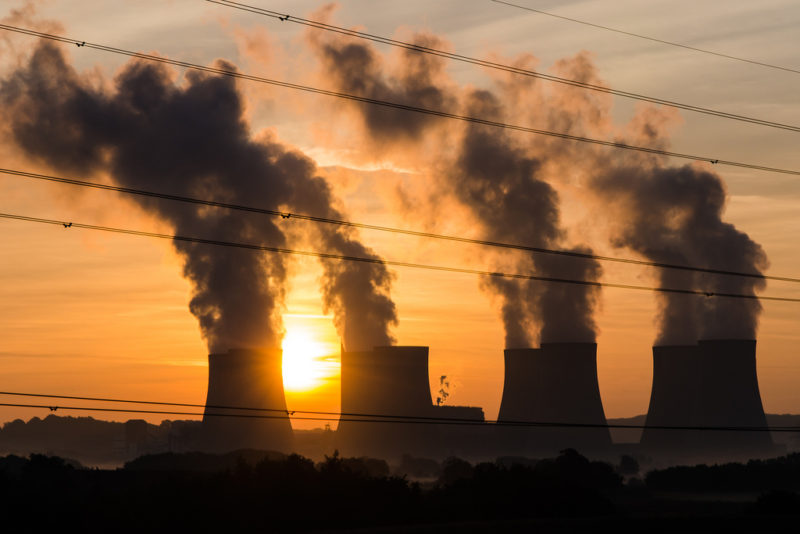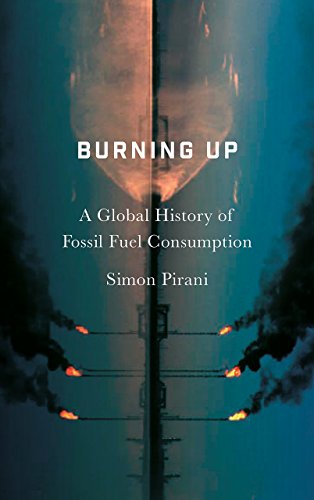The Madness Driving Climate Catastrophe
A new book examines how corporate capitalism, through fossil fuel-based technology, has led the world to the point of destruction. Gerry Machen / Flickr
Gerry Machen / Flickr

“Burning Up: A Global History of Fossil Fuel Consumption”
A book by Simon Pirani
The Great Acceleration: This is the designation given to the last 70 years during which industrial countries and a handful of newly rich developing countries extracted and consumed fossil fuels at a reckless rate. While accurate, the metaphor might suggest progress rather than the ominous atmospheric, terrestrial and oceanic climate trends ensuing.
The 20 hottest years on record have occurred since 1995, almost in tandem with the impotent U.N. climate negotiations begun in Rio de Janeiro in 1992 and followed by the Kyoto Protocol in 1997, Copenhagen in 2009, Paris in 2015 and Poland in 2018. Yet, even with near global consensus on the necessity of reducing climate-warming emissions radically by 2030 and (nonbinding) national pledges to do so, carbon dioxide (CO2) emissions rose by 2.7 percent in 2018. Moreover, some analysts predict they will rise higher in 2019 due to increasing deforestation, especially in Brazil’s Amazon rainforest. CO2 concentrations in the atmosphere have risen unremittingly to levels not prevailing since hundreds of thousands (and possibly more than 6 million) years ago.
Historian and energy researcher Simon Pirani likens this collective failure to act on climate change to the “collective madness” of World War I, in which old world imperial loyalties set loose the juggernaut of a mindless, pointless bloodbath of Europe’s boys and young men, ending only from morbid exhaustion on all sides. In “Burning Up: A Global History of Fossil Fuel Consumption,” Pirani sets out to plumb the political, social and economic causes of the “madness that is producing global warming.” His is a critically needed departure from much climate crisis writing (and activism) that focuses solely on technology, individual consumption and population growth as drivers of climate change.
“Burning Up” takes a structural and a muscular evidence-based tack; in doing so, it shows us the dominant axis of evil driving climate change. For example, though individuals are consumers of fossil fuel for electricity, heat, air conditioning, goods and services, the author contends, “they do so in the context of social and economic systems over which they may have little control.”
Corporate wealth-seeking and corporate power over the political elite drive the economy and determine the modes of technology, production and consumption—namely fossil fuels—for electricity, heating, cooling and commercial products (cement, steel, plastics); and as fuel for transportation and road building, construction and military.
The same corporate power grifters promote mass consumption through marketing, with hidden persuaders, and encode fossil fuel dependence through promoting car-oriented development globally.
Although a handful of large rich countries and some wealthier developing nations are included in this book, the United States is the central actor and agent for more reasons than its historical megaconsumption of fossil fuels. The U.S. has functioned as the stimulant and model for social, economic and political systems driving GDP growth in other rich and newly rich countries, resulting in fossil fuel use spiraling “out of control since the mid 20th century.” Not only that, but the U.S. mode of consumption is continually being reproduced across the world.
Pirani’s temporal focus is the 1950s to the present, coinciding with the postwar “great acceleration,” in which the impact of technology and economies on nature has been swift and drastic. Among his most cogent examples of political and economic elite driving climate change is the calculated design of cities for the car, now replicated throughout the world.
Car-centered transport in the United States between WWI and WWII “became a template for the world and shaped fossil fuel consumption patterns internationally.” Industry consolidated from 88 carmakers in 1921 to 10 in 1935, with the big three Ford, GM and Chrysler, encompassing 90 percent of the market and ranking among the most powerful corporate lobbies in the world. In the U.S., they bought up and shut down trolley systems, and helped displace railways with road transport for buses, trucks and cars. This stimulated car-centered urban design and urban renewal (in the case of older cities), and was embedded in the post-50s mushrooming of car-oriented suburbs. Government invested in building fossil fuel-intensive roads and highways through cities; manufacturers designed cars for obsolescence; and industry pioneered the annual style change in cars. All were the result of “corporate strategies to stimulate consumer demand,” even during the Depression.
As for the future, 55 percent of the world’s people now inhabit cities, with a projected increase to 68 percent by 2050. Car-based urbanization drives consumption of fossil fuels, especially because cities are not designed centrally for public transportation. And, as Pirani underscores, governments, developers, and corporate interests, not the individuals who live in them, shape the design of cities and constrain individual choice.
U.S. tax policy and subsidies enabled all early fossil fuel and nuclear energy transitions, whereas government support for emerging renewables pales in comparison. This is, as Pirani’s comparative data substantiates, a global phenomenon. In the United States, opponents of renewable technologies, promoters of fossil fuels and nuclear power, and diehard critics of government subsidies to renewable technologies have branded federal energy subsidies as an unfair handout to the solar and wind sector. In their view, these subsidies are a welfare program, giving an advantage to the renewables industry that would collapse if it had to compete with coal, oil, gas and nuclear.
However, a historical study of government subsidies to all energy technologies, not included in “Burning Up,” easily trounces this myth. Federal incentives for the first 15 years of subsidy life were five times greater for oil and gas and 10 times greater for nuclear power than for emerging renewable technologies. Indirect government support for fossil fuels and nuclear includes land grants for early timber and railroads for coal and other fuels. Early government-supported research and development for these energy industries was significantly greater than for renewables and efficiency. Moreover, there is no counterpart in renewable energy subsidies to the $7.3 trillion spent by the U.S. Department of Defense from 1976 through 2007 patrolling the Persian Gulf to protect U.S. oil shipments.
Finally, as many researchers predating Pirani have attested, the fossil fuel and nuclear power industries are not held financially liable for premature deaths and morbidity from air pollution from fossil fuel combustion, or for the costs of ultimate disposal of nuclear waste. Nor do the fossil fuel industries pay their fair share for their role in the record loss of species and coral reefs, the fivefold increase in natural disasters since 1970, and property damage due to global warming emissions.
Pirani’s closing chapters reinforce his opening message. Corporate capitalism and political elites have led us, by their dominant choice of fossil fuel-based energy and technology, to the point of “burning up.” Given they are leading the human race (and many other species) to extinction, he urges us to take the road less traveled: “… [T]he decisive actor [must be] society—all of it collectively—rather than political elites.”
I am reminded here of the precocious Greta Thunberg, the 15-year-old Swedish climate activist speaking at the U.N. climate conference in 2018 on behalf of the global youth climate movement. Every day the world uses some 100 million barrels of oil, yet “there are no politics to change that, no politics to keep the oil in the ground,” she said. “Since our leaders are behaving like children, we will have to take the responsibility they should have taken long ago. There is no time to continue down this road of madness. We have come to let them know that change is coming whether they like it or not. The people will rise to the challenge.” Since her speech tens of thousands of young students across the world are following her example, striking from school one day a week to pressure their governments to abide by their commitments to reduce climate change emissions.
Pirani concludes with steps to “breaking the resistance of incumbent interests” that are disappointingly general and, thus, not quickly actionable. In the spirit of his conclusion, I would point to a few recent standouts of taking action and taking back our future: the pragmatic and progressive Green New Deal; the meteoric rise of young political action groups like the Sunrise Movement in the U.S.; and the infectious youth climate action lawsuit Juliana v. U.S., filed by children and young adults against the U.S. government for failing to limit the effects of climate change on human health. May we be spared the time needed—given the rapidity of climate breakdown—to disrupt the hold of corporate wealth and power.
Your support matters…Independent journalism is under threat and overshadowed by heavily funded mainstream media.
You can help level the playing field. Become a member.
Your tax-deductible contribution keeps us digging beneath the headlines to give you thought-provoking, investigative reporting and analysis that unearths what's really happening- without compromise.
Give today to support our courageous, independent journalists.






You need to be a supporter to comment.
There are currently no responses to this article.
Be the first to respond.